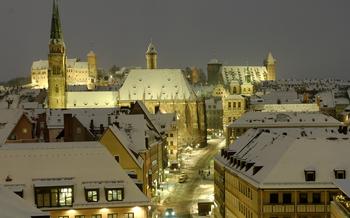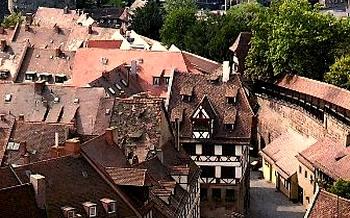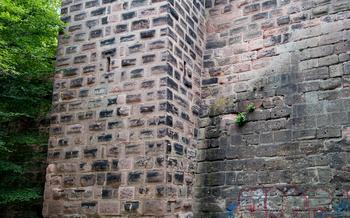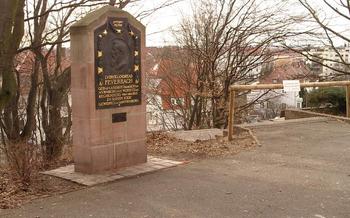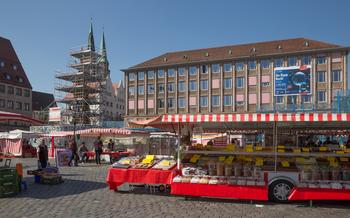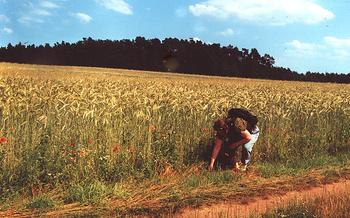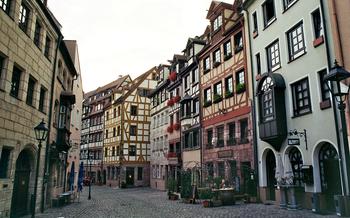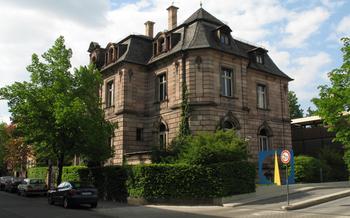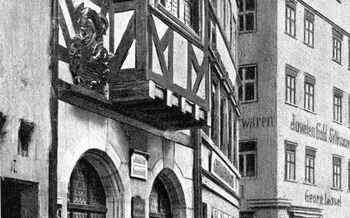
Altes Rathaus (Old Town Hall)
- The Altes Rathaus (Old Town Hall): A Gothic Masterpiece
- The Astronomical Clock: A Mechanical Marvel
- The Kaiserburg (Imperial Castle): A Majestic Fortress
- The Albrecht Dürer House: A Tribute to a Renaissance Master
- The Germanisches Nationalmuseum: A Treasure Trove of German History and Culture
- The Nuremberg Toy Museum: A World of Play and Imagination
- The Nuremberg Christmas Market: A Festive Tradition
- The Nürnberger Bratwurst: A Culinary Delight
- The Nuremberg Trials: A Landmark in International Justice
- Memorium Nürnberger Prozesse: Preserving the Legacy of the Trials
- The Nuremberg Transport Museum: A Journey Through Mobility
- Insider Tip: Discover Nuremberg's Hidden Gems
The Altes Rathaus (Old Town Hall): A Gothic Masterpiece
The Altes Rathaus, or Old Town Hall, stands as a testament to Nuremberg's rich history and architectural prowess. This Gothic masterpiece, constructed in the 14th century, once served as the symbol of the city's imperial power and wealth. Its intricate carvings, impressive facade, and rich ornamentation are a sight to behold, reflecting the artistic and cultural significance of Nuremberg during the Middle Ages.
The Altes Rathaus played a pivotal role in Nuremberg's history, serving as the seat of the city council and hosting important events that shaped the city's destiny. Its central location in the heart of Nuremberg's Old Town underscores its importance as a gathering place for citizens and a symbol of civic authority.
Exploring the Altes Rathaus is a journey through time. Its historical rooms, including the Imperial Hall, the Council Chamber, and the Treasury, offer a glimpse into the city's past and the decisions that shaped its future. Art and artifacts from Nuremberg's golden age adorn the walls, telling stories of the city's cultural heritage and the lives of its people.
Guided tours provide visitors with an in-depth understanding of the Altes Rathaus's history, architecture, and significance. Available in various languages, these tours offer a unique opportunity to delve into the stories behind the building's intricate details and explore the hidden corners that reveal the essence of Nuremberg's past.
The Astronomical Clock: A Mechanical Marvel
The Altes Rathaus is home to one of the oldest functioning astronomical clocks in the world, a remarkable feat of engineering and artistry that has captivated visitors for centuries. Constructed in the early 16th century, the clock is a masterpiece of mechanical ingenuity, featuring a complex system of gears, weights, and levers that orchestrate a mesmerizing performance every day.
At precisely noon, a procession of seven electors, representing the electors of the Holy Roman Empire, parades across the clock's stage. Each elector nods his head in turn, paying homage to the emperor. The Golden Cock, perched atop the clock, crows three times, symbolizing the betrayal of Christ by Peter.
The clock also features a sophisticated astronomical display, showcasing the positions of the sun, moon, and planets, as well as the zodiac signs. Visitors can marvel at the accuracy of the clock's celestial calculations, which have been guiding Nuremberg's citizens for over 500 years.
Multiple performances take place throughout the day, attracting crowds of onlookers who gather in the courtyard of the Altes Rathaus to witness this spectacle. Find a spot near the clock to enjoy the best view of the show, and be sure to arrive a few minutes early to secure a good position.
The Kaiserburg (Imperial Castle): A Majestic Fortress
The Kaiserburg, or Imperial Castle, is a majestic fortress that stands as a testament to Nuremberg's rich history and imperial legacy. Perched atop a sandstone hill overlooking the city, the castle served as the residence of the Holy Roman Emperors during their stays in Nuremberg. Its imposing towers, grand halls, and sweeping views offer visitors a glimpse into the grandeur and power of the imperial era.
The castle's history dates back to the 11th century when it was built as a fortification to protect the city. Over the centuries, it underwent several expansions and renovations, reflecting the changing needs and tastes of its imperial occupants. Today, the Kaiserburg stands as a harmonious blend of architectural styles, from Romanesque to Gothic and Renaissance.
Visitors to the castle can explore its many fascinating features, including the Imperial Hall, where lavish banquets and ceremonies were held; the Double Chapel, a unique two-story chapel with exquisite stained glass windows; and the Sinwell Tower, which offers panoramic views of the city and the surrounding countryside.
The Kaiserburg Museum houses a collection of artifacts and exhibits that tell the story of the castle's history and its role in the Holy Roman Empire. Visitors can learn about the lives of the emperors who resided here, the events that shaped the castle's history, and the significance of Nuremberg as an imperial city.
Whether you're a history buff, an architecture enthusiast, or simply someone who appreciates stunning views, the Kaiserburg is a must-visit attraction in Nuremberg. Its majestic presence and rich history make it a symbol of the city's enduring legacy and a reminder of the power and influence that once emanated from this imperial fortress.
The Albrecht Dürer House: A Tribute to a Renaissance Master
In the heart of Nuremberg's Old Town, near the bustling Hauptmarkt, stands the Albrecht Dürer House, a testament to the life and work of one of Germany's most renowned Renaissance artists. Step into this beautifully preserved 16th-century building and immerse yourself in the world of Albrecht Dürer, whose intricate engravings, paintings, and watercolors have left an indelible mark on art history.
The house-museum offers a glimpse into Dürer's personal and professional life. Explore the rooms where he lived, worked, and created some of his most famous masterpieces. Admire his original prints, paintings, and drawings, which showcase his exceptional skill and attention to detail. Learn about his artistic process, his influences, and the techniques he employed to achieve such remarkable realism and depth.
The Albrecht Dürer House is a must-visit for art enthusiasts and history buffs alike. It provides a unique opportunity to connect with the mind and soul of a true Renaissance master and gain a deeper appreciation for his extraordinary contributions to the world of art.
The Germanisches Nationalmuseum: A Treasure Trove of German History and Culture
The Germanisches Nationalmuseum, situated in the heart of Nuremberg, stands as a testament to the rich tapestry of German history and culture. Established in 1852, it ranks among the foremost cultural history museums in Europe, housing an unparalleled collection that spans prehistoric artifacts, medieval art, paintings, sculptures, and applied arts.
A visit to the Germanisches Nationalmuseum is akin to embarking on a journey through time, where visitors encounter relics from the Stone Age, marvel at exquisite medieval sculptures, and trace the evolution of German art from the Renaissance to the modern era. Among the museum's highlights are the Charlemagne Sword, a symbol of imperial power; the Venus of Willendorf, one of the oldest known representations of the human form; and the Nuremberg Chronicle, a lavishly illustrated account of world history from creation to the 15th century.
Guided tours are available in multiple languages, offering visitors the opportunity to delve deeper into the museum's vast collection and gain insights into the historical and cultural significance of its exhibits. Whether you are an art enthusiast, a history buff, or simply curious about German culture, the Germanisches Nationalmuseum promises an enriching and unforgettable experience.
The Nuremberg Toy Museum: A World of Play and Imagination
A Treasure Trove of Toys and Delights
Nestled in the heart of Nuremberg's Old Town, the Nuremberg Toy Museum is a magical realm where childhood dreams come alive. As one of the oldest toy museums in the world, it houses an extensive collection of toys from different eras and cultures, inviting visitors on a captivating journey through the history of play.
Interactive Exhibits for All Ages
The museum's interactive exhibits are a delight for children and adults alike. Kids can engage in hands-on activities, play with vintage toys, and even try their hand at toymaking. Meanwhile, adults can marvel at the intricate craftsmanship and historical significance of the toys on display.
A Glimpse into Childhood Memories
The Nuremberg Toy Museum offers a nostalgic trip down memory lane, evoking cherished childhood memories for visitors of all ages. Whether you're a seasoned toy enthusiast or simply looking for a fun and educational experience, this museum is sure to ignite your imagination and transport you to a world of wonder and play.
Workshops and Creative Activities
For those seeking a more immersive experience, the museum offers workshops and events where visitors can learn about toymaking and participate in creative activities. These workshops provide a unique opportunity to unleash your inner artist, create your own toy, and take home a cherished memento of your visit.
The Nuremberg Christmas Market: A Festive Tradition
The Nuremberg Christmas Market is a centuries-old tradition that draws millions of visitors each year. It is one of the oldest and most famous Christmas markets in Germany, dating back to the 16th century. The market is held in the heart of the city's Old Town, with over 180 wooden stalls lining the streets and squares. The air is filled with the scent of gingerbread, mulled wine, and roasted almonds, and the sound of Christmas carols and festive music.
Visitors can browse a wide variety of traditional Christmas decorations, handmade gifts, and local delicacies. The market is also a great place to sample Nuremberg's famous Lebkuchen (gingerbread), which is a type of sweet, spicy cookie that is made with honey, nuts, and spices. Other traditional Christmas dishes include roasted chestnuts, Kartoffelpuffer (potato pancakes), and Glühwein (mulled wine).
In addition to shopping and eating, there are also a number of other activities to enjoy at the Nuremberg Christmas Market. Visitors can listen to live music, watch traditional dance performances, or take a ride on the Christmas carousel. There are also a number of events and activities for children, such as storytelling, basteln (craft workshops), and a visit from St. Nicholas.
The Nuremberg Christmas Market is a magical experience that is sure to get you into the holiday spirit. It is a great place to find unique gifts, sample delicious food, and enjoy the festive atmosphere.
The Nürnberger Bratwurst: A Culinary Delight
A Taste of History and Tradition
Nuremberg's culinary scene is incomplete without mentioning the iconic Nürnberger Bratwurst. This small, plump sausage has a rich history and a unique flavor that has earned it a protected geographical indication. Made from a blend of pork, beef, and spices, the Nürnberger Bratwurst is traditionally grilled over beechwood charcoal, giving it a smoky and savory aroma.
Savor the Authentic Experience
The best way to enjoy a Nürnberger Bratwurst is to order a plate of three or six sausages, accompanied by sauerkraut and mashed potatoes. The crispy skin, juicy interior, and tangy flavor of the bratwurst pair perfectly with the sourness of the sauerkraut and the creamy texture of the mashed potatoes.
Where to Find the Best Bratwurst
To find the best Nürnberger Bratwurst, head to one of the many traditional restaurants or street vendors in the city. Some recommended spots include Bratwurst Röslein, Zum Gulden Stern, and Bratwurst Glöckl am Hauptmarkt.
Bratwurst Festivals: A Celebration of Culinary Heritage
Nuremberg's love for bratwurst is evident in the annual Bratwurst festivals held in the city. The most famous is the Nürnberger Bratwurst Glöckleinsmarkt, which takes place every December and attracts visitors from all over the world. During the festival, the streets of Nuremberg are filled with the aroma of grilled bratwurst, and visitors can indulge in this culinary delight while enjoying live music, traditional dances, and festive decorations.
The Nuremberg Trials: A Landmark in International Justice
The Nuremberg Trials, held in the aftermath of World War II, stand as a pivotal moment in the history of international justice. Convened in the Palace of Justice in Nuremberg, these trials brought to account high-ranking Nazi officials for their heinous crimes against humanity. The proceedings were meticulously documented, and the resulting Nuremberg Principles, adopted by the United Nations, became a cornerstone of international law, establishing the principle of individual responsibility for war crimes and crimes against humanity.
Guided tours of the Palace of Justice, where the trials took place, offer a profound insight into this momentous chapter in history. Visitors can explore the courtrooms, deliberate over the evidence presented, and learn about the challenges faced by the prosecutors and judges in holding the perpetrators accountable. The Nuremberg Trials left an indelible mark on the world, demonstrating the power of law to confront evil and seek justice, even in the face of unspeakable atrocities.
Memorium Nürnberger Prozesse: Preserving the Legacy of the Trials
The Memorium Nürnberger Prozesse, also known as the Nuremberg Trials Memorial, stands as a testament to the enduring legacy of the Nuremberg Trials. Its mission is to document, educate, and preserve the memory of this pivotal event in history. Through its interactive exhibitions, multimedia presentations, and historical artifacts, the Memorium offers a comprehensive exploration of the trials and their significance.
Educational programs form a crucial part of the Memorium's work. Workshops, seminars, and guided tours are tailored for students and adults, providing a deeper understanding of the trials and their impact on international law and justice. The Memorium also extends its reach through virtual resources, including online exhibitions, educational materials, and research opportunities, ensuring that the lessons of Nuremberg continue to resonate with audiences worldwide.
Visiting the Memorium Nürnberger Prozesse is an opportunity to engage with history, confront the atrocities of the past, and reflect on the importance of accountability and justice. Its commitment to preserving the legacy of the Nuremberg Trials serves as a reminder of the power of international cooperation in upholding human rights and preventing future atrocities.
The Nuremberg Transport Museum: A Journey Through Mobility
The Nuremberg Transport Museum is a must-see for anyone interested in the history and development of transportation. With a vast collection of vehicles, interactive exhibits, and special events, the museum offers a journey through the world of mobility.
The museum's collection includes a wide range of vehicles, from vintage cars and motorcycles to locomotives, aircraft, and even spacecraft. Visitors can explore the evolution of transportation technology through the ages, from the early days of horse-drawn carriages to the modern era of high-speed trains and electric vehicles.
Interactive exhibits and simulators allow visitors to experience transportation from a firsthand perspective. Visitors can take a virtual ride on a steam locomotive, try their hand at piloting an airplane, or race against the clock in a Formula One simulator.
The museum also hosts special events and exhibitions throughout the year, such as car shows, vintage vehicle rallies, and family-friendly activities. These events provide an opportunity for visitors to learn more about transportation history, meet with experts, and enjoy a day of fun and entertainment.
Insider Tip: Discover Nuremberg's Hidden Gems
Beyond the well-trodden tourist trails, Nuremberg offers a treasure trove of hidden gems waiting to be discovered. For a truly immersive experience, step off the beaten path and explore the city's lesser-known attractions. Visit the Stadtmuseum Fembohaus, a beautifully preserved half-timbered house that offers a glimpse into the life of a wealthy Nuremberg merchant family. Delve into the fascinating world of spices at the Gewürzmuseum, housed in a former spice warehouse. Admire the stunning collection of glass art at the Glasmuseum, showcasing the city's rich tradition of glassmaking.
Immerse yourself in local experiences by attending traditional festivals and events. Don't miss the Nuremberg Bardentreffen, a renowned international folk and world music festival held annually in the city's idyllic parks. Join the locals for a leisurely stroll through the Pegnitzauenpark, a scenic riverside park perfect for escaping the hustle and bustle of city life. Savor the flavors of Nuremberg's culinary scene by indulging in local specialties at traditional restaurants and markets. Try the Schäufele, a slow-roasted pork shoulder, or the Blaue Zipfel, a traditional dish of boiled potatoes and sauerkraut.
For unique souvenirs, head to the Handwerkerhof, a charming courtyard filled with artisan workshops and boutiques. Find handmade crafts, pottery, jewelry, and other treasures that capture the essence of Nuremberg's rich cultural heritage. To get around the city like a local, take advantage of Nuremberg's excellent public transportation system. Purchase a NürnbergCard, which offers unlimited travel on public transport, as well as discounts on attractions and museums. You can also rent a bike and explore the city's many bike paths, or simply wander on foot and discover hidden corners and alleyways that reveal the true charm of Nuremberg.
